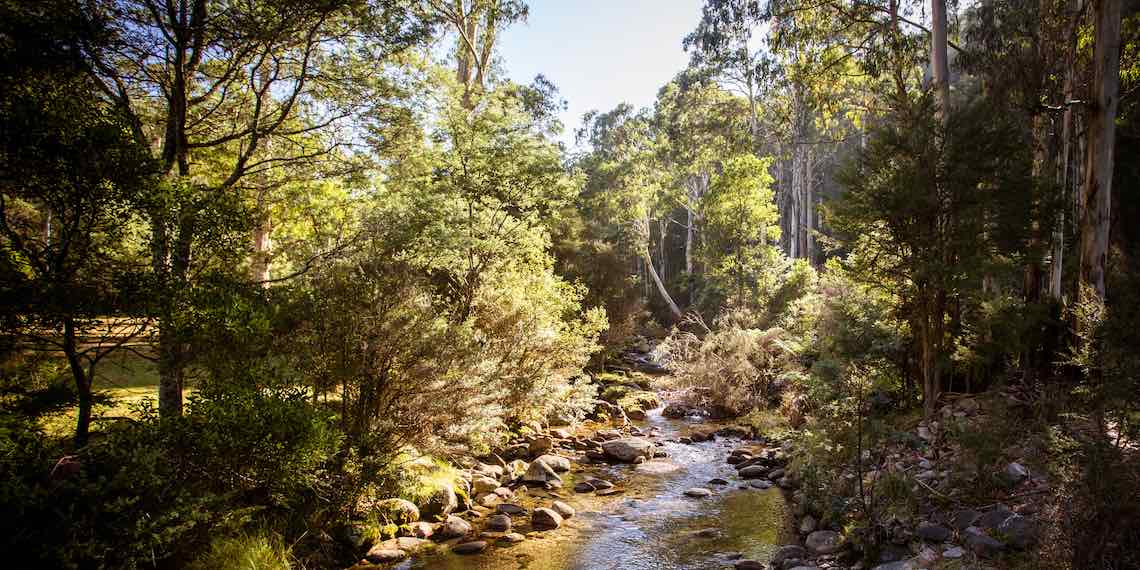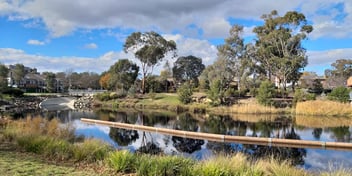There is a leak: understanding how waterways contribute to the carbon cycle

An effort to develop the first national model of carbon loss through rivers and streams in Australia is set to shed new light on how waterways contribute to the carbon cycle.
Working within the Charles Darwin University’s Research Institute for the Environment and Livelihoods, Dr Clément Duvert and Professor Lindsay Hutley have secured funding from the Australian Research Council’s Discovery Program to develop the model, which will involve assessing the amount of carbon stored and lost through different ecosystems.
Duvert said developing a clearer picture of the carbon cycle in Australia in relation to waterways is important as it will allow for more informed decision-making when it comes to carbon balance considerations and off-setting efforts.
“Carbon atoms are constantly in flux — they are constantly moving from one store or pool of carbon to another. Understanding the carbon cycle is really about trying to quantify the flux between these different stores,” he said.
“It’s really important to understand this flux because, with the increase of carbon being stored in the atmosphere due to the burning of fossil fuels, we want to understand where this carbon ends up and what we can do about it.”
While scientists are doing a good job of estimating how much carbon is stored in terrestrial ecosystems, Duvert said more work needs to be done to understand the movement of carbon between terrestrial stores and the atmosphere, particularly via waterways.
“We are just starting to realise that there is a leak. Not all of the carbon that is stored in ecosystems stays in ecosystems, some of it is leaking out via rivers and groundwater,” he said.
“We want more certainty around how much carbon ecosystems can actually store. We want to know the offset of this fluvial loss, otherwise we will be overestimating the ability of ecosystems to capture carbon.
“It’s really important to understand how carbon moves between stores so that we can manage offsetting more effectively. This research will help us know more about the actual offsetting potential of ecosystems.”
Finding the leak
Duvert said the recent floods on Australia’s east coast could have an important impact on the carbon cycle as massive amounts of carbon are lost from terrestrial ecosystems due to erosion and flooding, but that there is less certainty around where this carbon ends up.
“There is a lot of research in quantifying the terrestrial carbon sink and how much CO2 is being sequestered by our various ecosystems, but recently the scientific community has realised that not all carbon is stored, and some of it is being lost to groundwater and streams,” he said.
“The amount of carbon that is lost from ecosystems is directly related to the amount of water that transits through streams and rivers. So, during these major floods, the carbon loss can be massive. What is less known is the fate of this carbon once it's in the waterways.
"Most of this carbon that flows through rivers is not just going into the ocean and staying there. Most of the organic carbon stored in rivers – such as debris from trees and plants — decomposes in the river system and is degassed as CO2.”
Although big flood events increase the amount of carbon being released into the atmosphere, Duvert said large rain events also increase the productivity of ecosystems.
“It’s a complex exchange. While carbon is released from the terrestrial sink via flooding events, all that rain also helps the trees and plants grow, which then captures carbon, too. But we don’t really know what the net effect of this exchange is yet,” he said.
“We will be comparing the productivity of ecosystems with the carbon loss via rivers in order to generate a better understanding of how carbon is released and sequestered, and how these exchanges balance out.”
Measuring up
Assessing the national scale of fluvial carbon flux has not yet been done in Australia, but Duvert said it's needed in order to inform our carbon budget, and the work will start by measuring carbon transported in rivers right around Australia.
“We will be sampling many rivers and streams across the country. For each of the rivers and streams we will be measuring how much carbon they contain, including different forms of carbon, such as organic, inorganic and dissolved carbon,” he said.
“When we sample the rivers and streams, we will be capturing spatial variability. But we will also have some sites where we are measuring continuously by placing sensors in the waterway.”
Monitoring stations will be set up at eight to 10 sites across Australia, including at Litchfield National Park in the Northern Territory, on the Atherton Tableland in North Queensland and Warra Creek in Tasmania.
“These sites are an important aspect of how we will manage temporal variability within our model. We will be able to measure how much floods and droughts contribute to this flux,” Duvert said.
While Duvert and the research team cannot sample every river in Australia, they will also be developing a statistical model to fill in the gaps.
“We will be developing a statistical model that will help us predict the carbon flux in rivers that we have not sampled, based on data from other rivers,” Duvert said.
“We will be using machine learning, and some complex algorithms, which should allow us to have a full picture of how carbon is lost around the whole country through rivers.
“It’s quite ambitious, but it’s going to be the first estimate generated for this in Australia. So, even if we have high uncertainty, it will be a good start.
“The last step of the process will be to compare the carbon lost through waterways to the latest estimate of the productivity of the terrestrial stores. This will allow us to consider how much of the terrestrial carbon store is lost to rivers at both local and national scales.”
Informing management
This area of research is in its infancy in Australia, Duvert said, but there have been promising results from similar work conducted in Europe and the US.
“As we move towards a carbon economy, we will need to get much better at tracking carbon and understanding the role of different land uses, the role of different climates, in terms of how carbon is stored and released,” he said.
“There will be more and more research on these aspects in the next few decades. We are just starting in Australia. But there has been much more of this work done in other countries, especially in Europe and the US.”
Duvert said Sweden has been working on measuring carbon balances for over a decade, and has much more data and modeling that accounts for the loss of carbon through different ecosystems.
“Sweden has taken it a step further and is now looking at the effect of different land and waterway uses and management scenarios in order to mediate carbon loss,” he said.
“Sweden has a lot of forest plantations for industry. They have found that when they clear cut a large area of trees, leaving a buffer of forest along the rivers significantly reduces the amount of carbon that is leaking out of the soil,” he said.
“There are plenty of opportunities for this research to inform management practices. We are not there yet in Australia. But this work is the one step towards being able to inform land and waterway management decisions in ways that help us mediate the carbon balance.”

